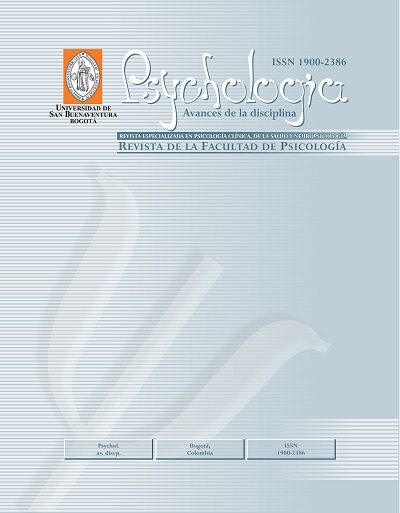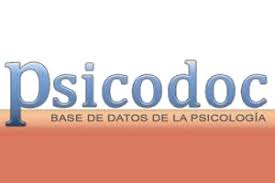This journal provides open, immediate access to its contents, based on the principle that offering the public free access to research helps to promote a higher global exchange of knowledge.
As such, all journal articles are published under a Creative Commons Attribution-NonCommercial-ShareAlike 4.0 International License (CC BY-NC-SA), by which commercial use of the original work or its possible derived works is not allowed, and the distribution thereof must be done with the same license elements regulating the original work.
http://creativecommons.org/licenses/by-nc-sa/4.0/
Abstract
Building upon Social Cognitive Theory, the purpose of the current study was to test a model in which self-efficacy beliefs influence job burnout and engagement, and to examine its invariance across Spanish (n = 1406) and Argentinean
(n = 687) employees from private and public sectors. A prospective expo facto study was carried out, using a structural equation model (SEM), and analyzes were also carried out on the internal consistency of the scales (α Cronbach) and MANOVA to analyze differences in the variables studied according to the country. The results of SEM and Analysis of Variance show that: (a) after incorporating some respecifications into the relationship model of selfefficacy, burnout and engagement, this is invariant in the two samples (χ² = 209.61, gl = 16, p <. 001, CFI = .94, IFI = .94, TLI = .94 RMSEA = .07); (b) professional self-efficacy has a negative and significant influence on the heart of burnout (β Argentina = -.25 and β Spain = -.22, p <.001), while the influence is significant and positive
with the heart of the engagement (β Argentina = .34 and β Spain = .41, p <.001). while it is positively associated with engagement levels, regardless of the country; (c) there are significant differences according to the country,
showing the Argentine workers scores significantly higher in self-efficacy (F = 107.13, p <.001). The results show that self-efficacy influences both burnout and engagement and this is maintained in both countries.
Keywords:
References
Bakker, A., van Veldhoven, M. & Xanthopoulou, D. (2010). Beyond the Demand-Control Model. Triving on High JobDemands and Resources. Journal of Personnel Psychology, 9(1), 3-16
Bandura, A. (1997). Self-efficacy: The exercise of control. New York: Freeman.
Bandura, A. (2001). Guía para la construcción de Escalas de Autoeficacia. (versión revisada). EE. UU.: Universidad de Stanford.
Bentler, P. (1990). Comparative fit indexes in structural models. Psychological Bulletin, 107, 238-246.
Bresó, E., Salanova, M. y Schaufeli, W.B. (2007). In search of the ‘third dimension’ of burnout. Applied Psychology: An International Review, 56, 460-478.
Browne, M. W, y Cudeck, R. (1993). Alternative ways of assessing model fit. En K. A. Bollen, y J. S. Long (ed.), Testing structural equation models (pp. 136-162). Newbury Park, CA: Sage.
Byrne, B. M. (2001). Structural equation modeling with AMOS: Basic concepts, applications and programming. Mahway, NJ: Lawrence Erlbaum.
Carlin, M., & Garcés de los Fayos Ruiz, E. J. (2010). El síndrome de burnout: Evolución histórica desde el contexto laboral al ámbito deportivo. Anales de psicología, 26(1).
Chen,G., Gully, S., & Eden, D. ( 2001) Validation of a New General Self-Efficacy Scale. Organizational Research Methods, Vol. 4 No. 1, 62-83
Cisneros, I; Medina, F.J; Munduate, L y Dorado, M.A. (2000). Consecuencias emocionales de la autoeficacia en situaciones de negociación. Apuntes de Psicología, 18, 97-121.
Cohen, J. (1988). Statistical power for the behavioral sciences (Second Edition). Hillsdale, NY: Lawrence Earlbaum Associates
Contini de González E. N. (2006) Multiculturalismo y psicopatología: perspectivas en evaluación psicológica. Psicodebate, 3, 91-106.
Eden, D., & Granat-Flomin, R. (2000). Augmenting means efficacy to improve service performance among computer users. Paper presented at the 15th Annual Meeting of the Society for Industrial and Organizational Psychology, New Orleans, LA.
Grau, r., Salanova, M. y peiró, J. M. (2000). Efectos moduladores de la autoeficacia en el estrés laboral. Apuntes de Psicología, 18 (1), 57-75.
Hoyle, R. H. (1995). The Structural Equation Modeling Approach: Basic Concepts and Fundamental Issues. En R. H. Hoyle (ed.), Structural Equation Modeling, Concepts, Issues and Applications (pp. 1-15). Thousand Oaks, Ca: Sage.
Iverson, R. D., y Maguire, C. (2000). The relationship between job and life satisfaction: Evidence from a remote mining community. Human Relations, 53, 807-839.
Lent, R. & Brown, S. (2008). Social Cognitive Career Theory and Subjective Well-Being in the Context of Work. Journal of Career Assessment ,16; 6-21: doi: 10.1177/1069072707305769
Lindley, L. D. (2006). The paradox of self-efficacy: research with diverse populations. Journal of Career Assessment, 14, 143–160. doi:10.1177/1069072705281371.
Llorens, S., García, M., y Salanova, M. (2005). Burnout como consecuencia de una crisis de eficacia: un estudio longitudinal en profesores de secundaria. Revista de Psicología del Trabajo y de las Organizaciones, 21, 55-70.
Marsh, H. W., Balla J. R., y Hau, K. T. (1996). An evaluation of Incremental Fit Indices: A clarification of mathematical and empirical properties. En G. A. Marcoulides, R. E. Schumacker (ed.), Advanced structural equation modeling, issues and techniques (pp. 315-353).
Mahwah, NJ: Lawrence Erlbaum Associates, Publishers.
Martínez, I. M., & Salanova, M. (2003). Niveles de burnout y engagement en estudiantes universitarios. Relación con el desempeño y desarrollo profesional. Revista de Educación, 330, 361-384.
Martinez, M. (2004). Ciencia y Arte en la Metodología Cualitativa. México: Trillas
Maslach C, Schaufeli WB, Leiter MP. (2001). Job burnout. Annual Review of Psychology. 52:397–422.
Nunnally, J. C., y Bernstein, I. H. (1994). Psychometric theory (3rd ed.). New York, NY: McGraw-Hill.
Olea, J., Ponsoda, V. y Prieto, G. (Eds.) (1999). Tests informatizados: fundamentos y aplicaciones. Madrid: Pirámide.
Pajares, P. & Urdan, T. (2006). Self-Efficacy Beliefs of Adolescent. United States of
Podsakoff, P. M., Mackenzie, S. M., Lee, J., y Podsakoff, N. P. (2003). Common method variance in behavioral research: A critical review of the literature and recommended remedies. Journal of Applied Psychology, 88, 879-903.
Salanova, M. & Llorens, S. (2008). Estado actual y retos futuros en el estudio del Burnout. Papeles del Psicólogo, 29, 59-67.
Salanova, M. & Llorens, S. (2008). Estado actual y retos futuros en el estudio del Burnout. Papeles del Psicólogo, 29, 59-67
Salanova, M. y Schaufeli, W.B. (2004). El engagement de los empleados: un reto emergente para la dirección de los recursos humanos. Estudios Financieros, 261, 109-138.
Salanova, M., Bresó, E. & Schaufeli, W. (2005) Hacia un modelo espiral de las creencias de eficacia en el estudio del Burnout y el Engagement. Ansiedad y Estrés, 11,215-231.
Salanova, M., Cifre, E., Grau, R. Llorens, S. y Martínez, I. (2005). Antecedentes de la autoeficacia en profesores y estudiantes universitarios: un modelo causal. En I. Martínez y M. Salanova (Dirs.) Burnout en la enseñanza, Revista de Psicología del Trabajo y las Organizaciones, 21, 159-176.
Salanova, M., Grau, R., Cifre, E., & Llorens, S. (2000). Computer training, frequency of use and burnout: The moderating role of computer self-efficacy. Computers in Human Behaviour, 16, 575-590.
Salanova, M., Grau, R., Martinez, I.M., Cifre, E., Llorens, S. y García-Renedo, M. (Eds.) (2004). Nuevos Horizontes en la investigación sobre Autoeficacia. Castellón: Colección Psique (nº 8). ISBN 84-8021-470-8. (pp. 294).
Salanova, M., Llorens, S., Cifre, E. y Martínez, I. M. (2012). We need a HERO! Towards a validation of the Healthy & Resilient Organization (HERO) Model. Group & Organization Management, 37, 785-822
Salanova, M., Llorens, S., Cifre, E., Martínez, I.M., & Schaufeli, W.B. (2003). Perceived collective efficacy, subjective well-being and task performance among electronic work groups. Small Group Research, 34, 43-73.
Salanova, M., Llorens, S., García-Renedo, M., Burriel, R., Bresó, E., y Schaufeli, W. (2005). Towards a four-dimensional model of burnout: A multi-group factor-analytic study including depersonalization and cynicism. Educational and Psychological Measurement, 65, 901-913.
Salanova, M., Schaufeli, W. B., Llorens, S., Peiró, J. M., y Grau, R. (2000). Desde el ‘burnout’ al ‘engagement’: ¿una nueva perspectiva? Revista de Psicología del Trabajo y las Organizaciones, 16, 117-134.
Schaufeli, W., Salanova, M., González-Romá, V. y Bakker, A. (2002). The measurement of burnout and engagement: A confirmatory factor analytic approach. Journal off Happiness Studies, 3, 71-92.
Schaufeli, W.B. y Bakker, A.B. (2004). Job demands, job resources and their relationship with burnout and engagement: A multi-sample study. Journal of Organizational Behavior, 25, 293-315.
Schaufeli, W.B. y Salanova, M. (2007). Efficacy or inefficacy, that’s the question: Burnout and engagement, and their rela tionships with efficacy beliefs. Anxiety, Coping & Stress, 20, 177-196.
Valiante, G. (2000) Writing Self-efficacy and Gender Orientation. A developmental Perspective. A Dissertation Proposal. Atlanta: Emory University.





















